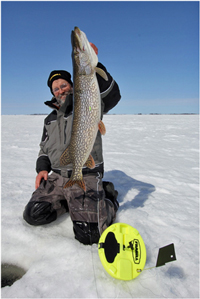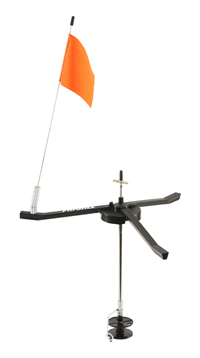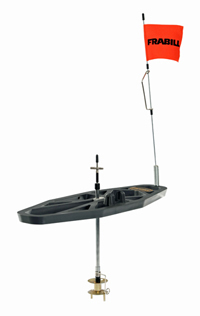
Northern Minnesota Fishing Reports Home
More Fishing Articles
|
Progressive Tip-Ups and Tactics - New tip-up designs solve age-old problems and introduce new ways to fish. - By Steve Pennaz .
The simple design of the rail style tip-up – like the Frabill Arctic Fire – is classic and functional, and my choice in most ice fishing situations. There are, however, situations where different styles perform better.
There are ongoing bait shop debates about the impact of sunlight coming through an open ice hole, particularly when snow cover cuts light penetration significantly. Some anglers refill a hole with ice shavings or snow to reduce light, particularly when fishing shallow and/or clear water. Others see no reason to take this step.
I am a fan of sight-fishing, and in the days before Aqua-Vu underwater cameras, I spent years in a blacked out fishhouse to maximize visibility. Besides learning how easily walleyes spook in shallow water, I found that nearby holes would allow a beam of light to penetrate when the sun was high. The fish didn’t seem to care about the light, but then most of the time I was targeting bottom-huggers like perch.
Then a few pieces started falling into place. Why did suspended ‘gills seem to shy away from larger ice holes? Why did shallow-running pike seem to drop more baits than deep pike, particularly when fishing tip-ups? Did light have a bigger impact on fish than I realized? Or was movement the problem…the jiggle of a rod-tip or tip-up going off?
Then last winter, while taping an episode of “Stone Cold Fishing” on Lake of the Woods, something happened that really opened my eyes.
We were targeting giant pike with both live and dead baits on a shallow flat. We kept the baits high, just 2-3 feet below the ice in 8 feet of water. The first fish, a thick 14-pounder, hit a live sucker. The second, a bruiser pushing 20, took a dead cisco. In total we had eight flags that afternoon. But here’s the interesting thing…none of them came on a rail-style tip-up. All the bites came on Frabill Pro-Thermal round tip-ups.
Why? We ran equal numbers of rail and round tip-ups and they were rigged identically. So I concluded that since the round tip-up blocked sunlight, the pike preferred the more natural setting.
That’s only one benefit of thermal round tip-ups. I’ve been in situations with temps in the double digits below zero with blowing snow and round thermals have been the only tip-ups that didn’t freeze up. Add that you can stack a half dozen in a five gallon bucket with no tangles or snagged kids, and I’m a big fan.
Scouting Panfish
At the beginning of last season I was introduced to a new, inexpensive tip-up design that got me rethinking tip-ups as a tool for panfish.
Aptly named “The Ice Spider,” it features legs that deploy in seconds and fold up neatly for easy storage. What lead to a whole new way of fishing panfish for me, though, are The Spider’s dual trip settings, one with more resistance for walleyes or the use of larger baits, and a lighter setting for panfish. The latter, combined with Frabill’s Ultra Glide spool shaft, means crappies and bluegills can suck in a panfish jig on light line and never be the wiser.
At first, the idea of using a tip-up for panfish was a bit weird. Yet, the longer I thought about it, the more it made sense. We started using Frabill Spiders to scout for active main basin crappies and discovered it was possible to stay on roaming biters by using a wide spread of tip-ups.
The system is pretty simple. We’d cut jig holes over main basin crappie spots, and then on the outskirts of the area we’d cut a series of three holes for every location we planned to set a Spider tip-up. Then we’d hole hop to find fish, and as soon as a Spider would go off, we’d run to it…one guy pulling up the biting fish while the other two dropped jigs on the active feeders in the two adjacent holes.
We’ve found the system also works well for scouting panfish over massive weed beds, especially funnel areas that fish use like highways.
Deep Snow Hack
Tip-ups and deep snow don’t typically play nice, especially when you’re already working with a foot to three feet of ice in February. Of course, one approach is to shovel out the snow around the hole, but then the flag is hard to see. That also leaves the hole exposed to freeze quickly.
With input from anglers in snow-heavy regions like Michigan’s Upper Peninsula and northern Canada, Frabill developed a tip-up that performs like no other in deep snow. Aptly named the Snow Shoe, it features a nearly-indestructible composite base in the shape of a show shoe to ride high in the snow. It has a long Ultra Glide spool shaft to reach down into the water for near frictionless free spooling off an extra large spool with 200 feet of line capacity. It also comes with a 17.5-inch flag stem to remain visible from afar. I know that when winter dumps on us, I’ll be ready.
Going Digital
No other tip-up demonstrates better how far we’ve come from the first handmade stick-styles. Called the Calibrator, it’s basically a Snow Shoe with a tiny digital LCD mini computer that records the depth of your bait, time of bite, time since the bite and the amount of line taken by the fish.
The genius of this tip-up design is that you can consistently set your bait at the same depth – no need for arm stretches or sinking a transducer. Last year I found this made bait-checking a lot quicker—and invariably led to more fish on the ice. Likewise, for those situations when you miss a tripped flag, it’s handy to know how long the fish has had the bait.
For example, there was a situation last winter when I didn’t realize a flag had tripped. The Calibrator display told me that the fish bit 5 minutes ago, yet hadn’t taken out much line. Unlike pike or bass, whose tendency is to run with the bait, walleyes will often stay close to the hole.
Lastly, I found it versatile for not only walleyes but pike and lake trout in the heavier trip setting, which allowed me to size up and fish big bait on big rigs. I don’t know how much time I’ve wasted over the years chasing flags only to discover a big sucker minnow has tripped the flag.
Don’t be fooled into thinking tip-ups are old school, or that one size fits all. Rather, tip-ups have become as sophisticated as ice fishing rods and there’s a well-suited style for every fishing situation.
ABOUT
"Award-winning fisherman/jounalist, creator of Knot Wars, formerly with the North American Fishing Club, Steve Pennaz has launched Lake Commandos, a new brand that includes Lake Commando television/social media series on Pursuit Network and TuffTV." |

Pennaz concludes that since the round tip-up blocked sunlight, the pike preferred the more natural setting.

The Spider’s dual trip settings, one with more resistance for walleyes or the use of larger baits, and a lighter setting for panfish.

The Snow Shoe features a nearly-indestructible composite base in the shape of a show shoe to ride high in the snow. It has a long Ultra Glide spool shaft to reach deep down into the water.
|


